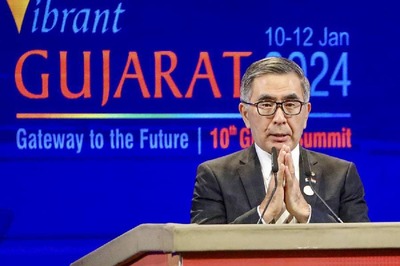
views
CHENNAI: A young mother carries construction material on a pan neatly balanced on her head while her children find entertainment rummaging through the rubble at the construction site — the familiar picture painted in our minds about the children of migrant labourers.Ragged clothes, unkempt and sun-bleached hair and faces stained by a runny nose complete the canvas.However, that picture is set to change. At the Hiranandani Palace Gardens Township near Oragadam, Chennai, these children are dressed in cheery red shirts and checkered shorts. They wear glittering smiles on their clean faces as some of them sing nursery rhymes while others get busy building their dream tower with building blocks.“This centre gives me much joy and contentment in comparison to raising a verdant township,” said Utpal Dhar, COO of Hiranandani Infrastructure and Real Estate Company.The day care centre at HIRCO property near Oragadam, is located in the midst of many shady trees and a spacious playground and was started in December 2008 with a commitment to cater to the education and health needs of the children of migrant labourers to take care of their early childhood.“Look at the US President Barack Obama and our former President Abdul Kalam. They are where they are because of education.We do not know where talent lies; it is not necessarily with the rich or the affluent,” said Dhar. They have 75 children enrolled in this daycare centre, most of which come from Orissa, Bihar, West Bengal and Andhra Pradesh.The centre uses an activity- based method of learning and the medium of education is English, though Hindi is also spoken at the centre. Adequately staffed, they have an integrated curriculum comprising basic English, maths, social science and environmental science.“When a child is taught in English, when they grow up, it is easier to mainstream those migrant children, even when they go back to their own states,” said Aparajitha Ramadyani, a one time copturned- educationist who is now the General Manager of Administration at HIRCO when discussing the advantages of English as the medium of instruction.However, educating these children is not without its own set of challenges, according to Aparajitha.“The first thing that I like to point out is the lack of continuity in education, because they work here for six months then they go back to their states. Some of the parents come back, with their children, for whom we are able to continue the education, but many do not come back if they get other opportunities elsewhere,” she said.Apart from education, the nutritional needs are met with a complete planned diet of eggs, milk, vegetables and cereals. The children are engaged in indoor and outdoor games, that help them develop social skills.This centre can take credit for toilet training not just the children but also their parents. Aparajitha shared, “Hygiene was bad with the migrant workers, given that they are always on the move. So, over a period of time, we have taught the children the importance of using the toilets and to wash their hands with soap. Now the children have started telling the parents to do it.Now, open defecation has really come down among the migrant population.” The Building and other Construction Workers Regulation of Employment and Condition of Services Act 1996, states that if 50 or more women workers are employed in a site, the builder should provide a crèche (day care centre) for their children.The Contract Labour Act also mandates the builders to provide a crèche if they employed more than 50 women workers.Geetha Ramakrishnan, Additional National Secretary, Nirman Mazdoor Panchayat Sangam, who had been working on the issues of construction labourers for over three decades, said, “Though these laws mandate the builders to provide creche to the children, almost 99 per cent of them do not follow it. It is very rare if any builder is following it. I would say this initiative by HIRCO is positive and we welcome it.I hope all the builders take up such initiatives.”




















Comments
0 comment